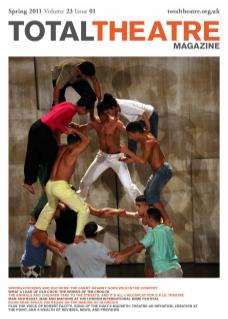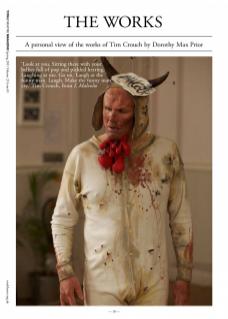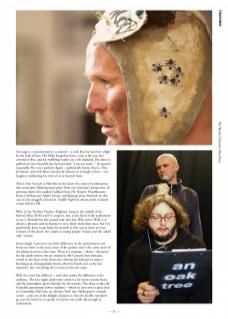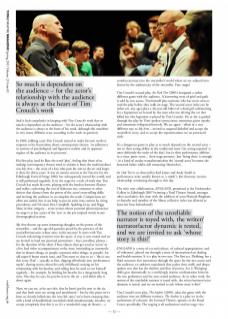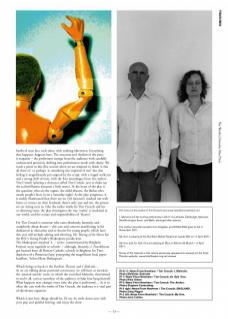On stage is a man dressed as a cockerel – a cock that has just lost a fight by the look of him. His filthy longjohns have a tear at the rear, he’s covered in flies, and his wobbling wattles are a bit lopsided. His chest is puffed out, but his pride has been pricked. ‘I am not mad…’ he mutters repeatedly. He cuts a pathetic figure – pathetically funny, that is. This he knows, and with bitter sarcasm he exhorts us to laugh at him – our laughter confirming his view of us as boorish louts.
This is Tim Crouch as Malvolio in the latest of a series of productions that reinterpret Shakespearean plays from one character’s perspective. In previous shows he’s tackled Caliban from The Tempest, Peaseblossom from A Midsummer Night’s Dream, and Banquo from Macbeth. In this case it’s the priggish steward in Twelfth Night for whom pride certainly comes before a fall.
We’re in the Pavilion Theatre, Brighton, bang in the middle of the festival (May 2010) and I’ve crept in, late, at the back of the auditorium to see I, Malvolio for the second time that day. Why twice? Well, it is always a pleasure and an honour to see a show more than once, but I’m particularly keen to get back for seconds in this case as there are two versions of this show: the ‘aimed at young people’ version and the ‘adults only’ version.
Interestingly, I perceive very little difference in the ‘performance text’ from one show to the next: most of the spoken text is the same; most of the physical action is the same. There is a costume – ahem – alteration for the adult version (we are treated to Mr Crouch’s bare buttocks, waved in the faces of the front row, whereas the kids get to enjoy a fetching pair of leopardskin boxers when he bends over at the key moment), but everything else is more-or-less the same.
Well, the same but different – and what makes the difference is the audience. The late-night adult-only crowd is a far more raucous beast, and the atmosphere grows bawdier by the minute. The show evokes the Grimaldi pantomime-clown tradition – which in turn owes a great deal to Commedia Dell Arte, an obvious ‘feed’ into Shakespeare’s comedy scenes – and one of the delights of panto is that the double entendres go over the head (so to speak) of anyone not really old enough to understand.
And it feels completely in keeping with Tim Crouch’s work that so much is dependent on the audience – for the actor’s relationship with the audience is always at the heart of his work, although this manifests in very many different ways according to the work in question.
In 2003, jobbing actor Tim Crouch started to make his own work in response to his frustrations about contemporary theatre, ‘its adherence to notions of psychological and figurative realism and its apparent neglect of the audience in its processes’.
His first play (and he likes the word ‘play’, feeling that those of us making contemporary theatre need to reclaim it from the traditionalists) was My Arm – the story of a boy who puts his arm in the air and keeps it there for thirty years. It was an instant success at the Traverse for the Edinburgh Festival Fringe 2003; has subsequently toured the world; and is still performed regularly. It set the stage for a style of work that Tim Crouch has made his own: playing with the borders between illusion and reality; eschewing the sort of elaborate sets, costumes or other devices that distract from the power of the actor’s storytelling skills; and inviting the audience in to complete the work. Comparisons are often not useful, but it can help to put an artist into context by citing precedents, and I’d count Ken Campbell, Spalding Gray, and Peggy Shaw in that category – actor-writers whose personal physical presence on stage is as key a part of the ‘text’ as the pre-scripted words or prechoreographed actions.
My Arm throws up some interesting thoughts on the power of the storyteller – and the age-old question posed by the presence of the storyteller/narrator: whose story is this anyway? It starts with Tim Crouch welcoming everyone into the space. A tray is sent round and we are invited to lend our personal possessions – keys, jewellery, photos – for the duration of the show. These objects then get used as ‘actors’ in a live feed video accompaniment to the story (reminding us constantly that in theatre things, or people, represent other things, or people). An old super-8 home movie runs, and Tim starts to chat to us – ‘this is me, this is my Dad’ – casually at first, slipping effortlessly into ‘performance mode’, sharing stories about his early childhood, musing on his relationship with his brother, and telling how he used to test himself regularly – for example, by holding his breathe for a dangerously long time. One day, he says, he put his arm in the air – and didn’t take it down again.
Now, we can see, as he says this, that he hasn’t got his arm in the air, and that both arms are strong and unwithered – but by this point we’ve been so cleverly lulled into the ‘true life story’ we’ve been enjoying that, with a kind of doublethink two-beliefs-held-simultaneously mindset, we accept completely that this is so. It’s a wonderful coup de theatre – a seamless journey into the storyteller’s world where we are seduced into fiction by the authenticity of the storyteller. Pure magic!
Tim Crouch’s second play, An Oak Tree (2005) instigated a rather different game with the audience. A harrowing story of grief and guilt is told by two actors, Tim himself plus someone who has never seen or read the play before they walk on stage. The second actor (who can be either sex, any age) plays a 46-year-old father of a dead girl volunteering for a hypnotism act hosted by the man who was driving the car that killed her (the hypnotist is played by Tim Crouch). He or she is guided through the play by Tim’s spoken instructions; sometimes given openly, and sometimes whispered furtively. We are again – albeit in a very different way to My Arm – invited to suspend disbelief and accept the storyteller’s story, and to accept the representations we are presented with.
It’s a dangerous game to play as so much depends on the second actor – not in their acting ability in the traditional sense (‘no acting required’ is most definitely the order of the day), but in their performance abilities in a truer, purer sense… their stage presence. Just ‘being there’ is enough – in a kind of secular transubstantiation the ‘second actor’ becomes the bereaved father whilst still remaining ‘themselves’.
An Oak Tree is co-directed by Karl James and Andy Smith (a performance artist usually known as ‘a smith’), this threeway creative relationship continuing through to this day.
The trio’s next collaboration, ENGLAND, premiered at the Fruitmarket Gallery in Edinburgh 2007 (winning a Total Theatre Award, amongst other accolades), this time with the addition of actor Hannah Ringham, co-founder and member of the Shunt collective (who was allowed to learn her lines beforehand!).
ENGLAND is a story of art and culture, of cultural appropriation, and of ‘otherness’, played out through a story of international art dealing and health tourism. It is a play in two acts. The first act, Dabbing, has a fluid structure: free movement through the space for the two actors and the audience; an ambient soundtrack that pulses then swells and drops; spoken text that has the rhythm and flow of poetry. Act 2, Wringing, shifts gear dramatically to a terrifyingly intense confrontation between the two performers and the now-seated audience. As in other work, the notion of the unreliable narrator is toyed with, the writer/narrator/actor dynamic is tested, and we are invited to ask ‘whose story is this?’
Tim Crouch’s next play, The Author (2009), takes the game with the audience into yet different territory. The Author is a play set in the auditorium of a theatre: the Jerwood Theatre, upstairs at the Royal Court, specifically. The staging is all auditorium and no stage: two banks of seats face each other, with nothing inbetween. Everything that happens, happens here. The structure and rhythm of the piece is exquisite – the performers emerge from the audience with carefully orchestrated precision, shifting into performance mode with clarity. We reach a point in this first section when we are tempted to think ‘is this all there is?’ or perhaps ‘is something else required of me?’ but that feeling is magnificently pre-empted by the script, with a staged walk-out and a strong shift of tone, with the first monologue from ‘the author’, Tim Crouch (playing a character called Tim Crouch, just to shake up the reality/illusion dynamic a little more). At the heart of the play is the question: who are the rapists, the child abusers, the blokes who smash people’s faces in on a Saturday night? As the play progresses, it is starkly illuminated that there are no ‘evil monsters’ marked out with horns or crosses on their forehead: there’s only you and me, the person we are sitting next to. Like the earlier works by Tim Crouch and his co-directing team, the play investigates the way ‘reality’ is mediated in our world, and the nature and responsibilities of ‘theatre’.
For Tim Crouch is someone who cares absolutely, honestly, and completely about theatre – this care and concern manifesting in his dedication to education and to theatre for young people, which later this year will include editing and directing The Taming of the Shrew for the RSC’s Young People’s Shakespeare production. The Shakespeare-inspired ‘I…’ series, commissioned by Brighton Festival, tours regularly to schools – although, bizarrely, I, Peaseblossom got banned from all Roman Catholic schools in Brighton for Tim’s depiction of a flirtatious fairy, prompting the magnificent local paper headline, ‘School Bans Shakespeare’.
Which brings us back to the Pavilion Theatre and I Malvolio… As we are talking about potential controversy, we will have to mention the ‘assisted suicide’ scene, in which the wretched Malvolio, determined to end it all, coerces members of the audience to help him hang himself. What happens next changes every time the play is performed… As is so often the case with the works of Tim Crouch, the audience is a vital part of the theatre equation.
Which is just how things should be, I’d say. So settle down now with your pop and pickled herring, and enjoy the show.
For more on the works of Tim Crouch see www.newsfromnowhere.net
I, Malvolio will be touring extensively in 2011: to Latitude, Edinburgh, Moscow, Stratford-upon-Avon, and Bath, amongst other places.
The Author recently toured to Los Angeles, and ENGLAND goes to LA in November 2011.
My Arm is playing at the Northern Ballet Theatre at Leeds Met on 11 April 2011.
My Arm and An Oak Tree are playing at Bios in Athens 30 March – 2 April 2011.
Some of the material in this article previously appeared in reviews on the Total Theatre website: www.totaltheatre.org.uk/reviews
